
The following article was initially published on FasterSkier on April 2, 2003. It was written by Pete Vordenberg, who at the time was the assistant coach of the U.S. Ski Team, under head coach Trond Nystad.
Nystad’s boss was Luke Bodensteiner. The development coach was Chris Grover. Athletes on the men’s national team included Justin Wadsworth, Carl Swenson, Torin Koos, Kris Freeman, and Andrew Johnson, plus a grand total of one (1) woman, Wendy Wagner. If you’ve followed American nordic skiing at any point in the last 20 years, you likely recognize some or all of these names.
This article is the first of a four-part series, which Vordenberg published on FasterSkier over a few days in April 2003, looking back on the just-completed 2002/2003 season. It is, like many archival pieces in this series, both timeless and dated. The athletes train hard in the morning, rest in the middle of the day, then have a second training session in the afternoon. That much is familiar. The athletes are expected to spend much of the summer and fall living in Park City, where a national-team skier works at Home Depot during his recovery window. That much is less so.
Finally, the genre of this document itself likely deserves comment: This is the second-in-command of the USST, drafting a candid memoir in these humble pages. This is, as the saying goes, tremendous content; I found this entire series compulsively readable, and am thrilled that Vordenberg took the time to write it.
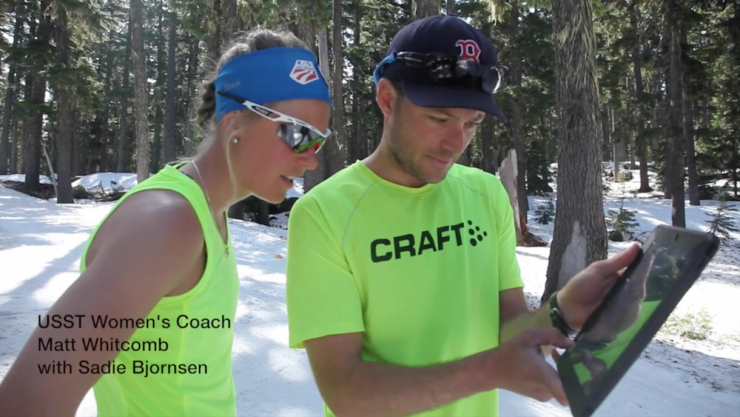
It is also, perhaps, reflective of the evolution of this site and how information from national team coaches is passed on to the devoted cross-country fans following from the U.S. While it’s unlikely that Matt Whitcomb or Chris Grover would write something comparable in length for FasterSkier anytime soon, Whitcomb took the time to speak with FasterSkier after virtually every World Cup or Olympic race this past season, while Grover remained quick to respond and support our coverage by phone or email. Grover also recorded an interview with FasterSkier editor Rachel Perkins earlier this week that will be featured on the Nordic Nation podcast tomorrow. It’s a shift from the written word toward more audio-based media, but the dedication of the U.S. Ski Team coaches remains unchanged.
This piece also feels like a reflection of its era, and of the unique energy that Vordenberg brought to it. As for the era, this was, in both ski years and tech years, generations ago; there was a certain informality to early-aughts cross-country ski journalism that has, for better or worse, largely leached out of the current incarnation of FasterSkier. The unfiltered stuff is all on Instagram now. And as for Vordenberg, well, if you compare this piece with either his book or a published interview with the man, suffice to say that he has a well-defined voice.
Next month will mark 20 years since the opening scene of this article, set in mid-June, 2002. It will still be hot in Park City. El Chubasco will still feed hungry skiers. Chris Grover will still be coaching the national team. It will still be impossible to look cool while doing spenst. Athletes will still spend the summer rollerskiing, running, and doing strength, while dreaming big dreams about the race season ahead. The work will still continue. As Vordenberg writes here, “Even among the youngest athletes on the team there are no spring chickens, no overnight successes. Believe that.”
* * *
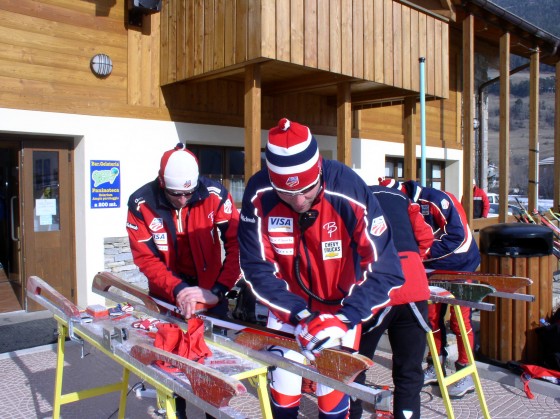
A tale of the US Ski Team’s 02-03 Season – Part 1
(by Pete Vordenberg, April 2, 2003)
I first met Trond Nystad in Norway in 1993. We had raced each other the previous season at the NCAA Championships but did not meet. He beat me at that Championship, which I considered a fluke, and he likely considered status quo. In Oslo, where we met, we did not say as much, but like dogs meeting for the first time at the ends of their leashes, we would have tangled if given the chance – just to see who was tougher.
Later we were teammates on the Factory Team, and there became friends. We trained, traveled and raced together all over the US for a few seasons. Train, Travel and Race with someone and you come to either respect them… or not, to like them, or not.
Over the next five years I came to both like and respect Trond. We were competitors first and friends finally. And this is important, because I have just spent the past two months with Trond in such close quarters as to be literally living out of the same suitcase, and before these past two months, the two months prior to that, and before that, save for a few blessed weeks around Christmas, we have been together nonstop since June when he hired me as his assistant.
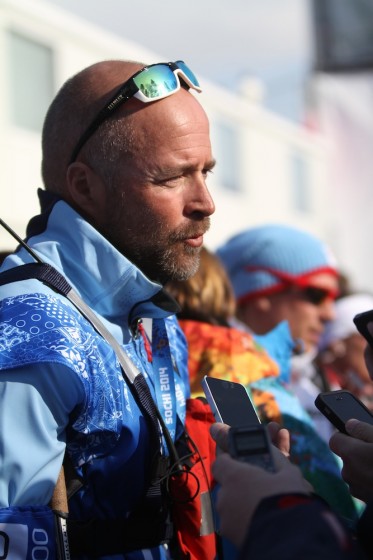
Trond is the head coach of the U.S. Cross-Country Ski Team. I am the assistant coach. Our boss, the man who hired Trond and, at Trond’s request, me is Luke Bodensteiner. Luke is a man who if we were dogs I would hope was restrained by a strong leash, a heavy chain, for there is no hope tangling with Luke. Luke is in the captain’s chair. He is the man who would go down with the ship if it were sinking, and he is the reason it is not sinking. He is bulletproof – the target of many ski snipers. I know. I have shot at Luke. I still shoot at Luke – though these days more constructively.
This is the tale of Trond and my first year with the team as coaches, the tale of the US Ski Team’s 02-03 season. It is told from my perspective and my perspective alone – not necessarily that of the U.S. Ski Team or anyone else connected to it. There are stories and some detailed info on our training and technique as well as racing, travel and life on the road… enjoy.
* * *
Trond gathered the troops for the first time in mid-June. Park City, Utah was ninety-five degrees. It was one-ten in Salt Lake. We sat together for the first time as a group, sweating. There is Chris Grover, Development Coach. He is the man behind Kris Freeman and Andrew Johnson’s rise from the top of the junior to the top of the senior ranks. Chris has helped revolutionize how we train strength and how we teach and understand technique in the US. There is Chris Hall, our wax and ski man, Katie Gould, our manager. There is Luke and Trond, and me.
There is Justin Wadsworth, the oldest member of our team, staff included. Justin was racing in his first world championships in 1989 while I still had a year of high school left. Carl Swenson is the second oldest member of the team, staff included. Carl, Luke and I raced each other as juniors – we go way back.
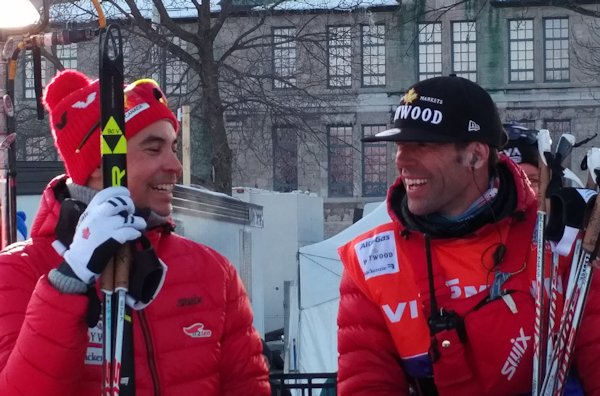
Justin, Carl, Luke and I were teammates together on the US Team ten years ago. We had ideas on what could be better – a lot of ideas.
There is Wendy Wagner, our only woman on the National Team. I have known her since she was a star at Western State College. In 1997 we took a trip together to race a series of races in Northern Sweden. That is what a lot of people don’t know or understand. These racers have been at this a long time. Long before you ever heard of them they were training and racing and paying their own way to race four times a week and ride around places like Northern Sweden in an over-crowded van dreaming of one day being fast enough to win medals.
Even among the youngest athletes on the team there are no spring chickens, no over night successes. Believe that.
Just because the first time you ever heard of Torin Koos was at the 2001 pre-Olympics [Nationals] doesn’t mean he rolled off the hay wagon that morning. Torin Koos can run a mile in four-minutes and five seconds. He spent his youth panting around the oval and skiing in the North West’s sloppy excuse for snow, and these things he has done a lot. And he is the youngest on the team, the one with the least amount of training behind him.
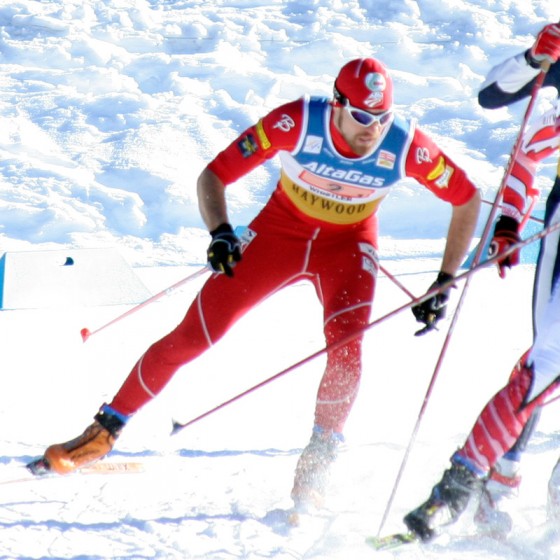
The next youngest is Kris Freeman. Kris trains close to 800 hours a year, and has for several years. So has the next youngest, Andrew Johnson. Kris and Andrew can be grouped together because they are the first skiers to come from the new school of thought in US Skiing. It is more of a hands-on approach. They have lived and trained together under the guidance of Chris Grover, and now Trond and I, for three years – year round. They were good to start with and they got better.
This year Kris won the World Under-23 Championships, the 30km, by a minute forty-five. He was fourth in the 15km at the regular World Championships, seconds from a medal… feet from the gold. He was only seconds from the win in the Skiathlon (running-pursuit) at the Worlds, and won the opening leg of the relay. He dominated the opening leg of the World Championship relay. Damn.
Carl Swenson took fifth in the 50km, was a second closer to a medal than Kris in the Skiathlon, and had the fifth fastest relay time. Damn. That is fast.
That is Koch fast, or almost.
New Koch! Coming soon!
* * *
Our first task that sweaty June was to create a team. This task took priority over all others – over training, over results. Over everything becoming a cohesive team was the number one priority. Together we could succeed in an atmosphere of support, open communication, confidence and fun. To solidify this notion we would jump, as a team bonding exercise, from a 440 foot cable car toward a shallow rocky river below… but that is later.
Cohesion is not so tangible as medals. How do you measure its success? By medals? No, for, though not likely, you can win without it and you can fail in spite of it. I measure it in hindsight. It was not a total success. There are yet bugs in the system. We have more work to do. But it was a big success. I know this because as I write this I am on my way home on a plane from a long stint traveling and racing in Europe with the same small group of people, which followed on the heals of a long stint in Maine, which followed a long stint on the road all over the Western US, Fairbanks, Alaska and Canada which followed a long stint training and coaching in Utah and New Zealand all with the same small group of people – and even after all this I don’t want to kill any of them. That is success. We have communicated well, we have talked through the difficult situations that have and will inevitably arise. And we are all in one piece. I’ll call it a good start.
* * *
“Yo homes! How’s it hanging?” is Trond’s patented greeting.
It is July and team training has begun in earnest. Team training, not training. The athletes have been training since their last race last April. In July we start official team training. We train together at least once a day, more often twice a day.
A typical July day we meet at the ski team office at eight. The skiers are there at seven fifty-five. “Five minutes early” is team cohesion policy number seven. There are fifteen policies. The athletes came up with them.
“Yo homes, how’s it hanging?” says Trond.
“You’re late, man,” says Andrew – smiling. It is eight, but as we are not early, we are late. Communicating openly and in a timely manner is cohesion policy number three. We operate by these policies.
We load in the van and depart for training at roughly twenty times the appropriate speed. We came together easily, fell into our routine as if it were habit, and it is habit. At the start of the rollerski road the skiers pile from the van, pull poles and skis out behind them and in pairs, singles and small groups (the Development team is training with us too) start off down the road.
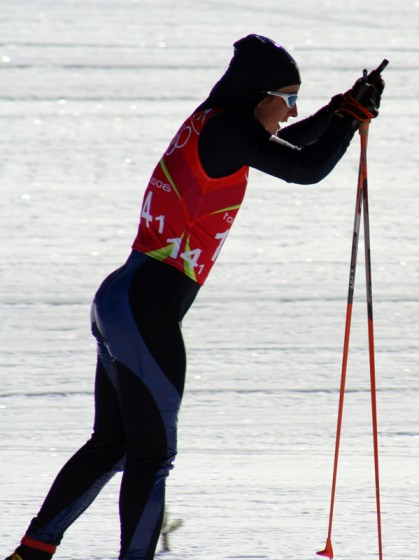
Today Trond stays in the van and drives. I get out and ski with Wendy and Aelin Peterson who trained with us much of the summer. Trond zooms ahead, stops and takes video. He stops skiers, offers some technique advice, takes some lactate measurements to make sure everyone is going the right pace, jumps in the van and zooms ahead again. I offer a few technique suggestions to Wendy and Aelin as we ski, watch them, see what I think they could do better. Being open to constructive criticism is policy number eight – Wendy and Aelin play with my suggestions, make adaptations, feel for themselves what works.
Some days I drive, take video and lactate measurements and Trond skis. Sometimes Chris Grover drives. We have to trade off, or we’d die from the training. We are ex-racers all of us. The Italian National Team is coached by an ex-racer; the German National Team is coached by an ex-racer. The Norwegian team’s coaching staff is full of ex-racers, as is the Swedish staff… it is likely we all had ideas on how it could be done better. Now we have the chance to do it.
After the rollerski we return to the Ski Team office, the athletes go home, or head to El Chubasco for lunch. El Chubasco is awesome.
* * *
A typical morning distance session is two hours. We do it in level 1; only on a few hard climbs do they hit level 2. They move with snappy, powerful yet relaxed technique even at this easy pace. They generally throw in sprints along the way – just pick-ups of around ten seconds. Technique is always a focus. Training is not social time. There is little conversation, save for the coaches making suggestions. In training they focus on training. Anything else is just going through the motions.
Midday there are projects for the coaches and rest for the skiers… most of the skiers. Andrew Johnson heads to work at Home Depot in Salt Lake. It can be a hundred and twenty on the asphalt down at the Depot in Salt Lake. Andrew works inside. Skiers have a very hard time supporting themselves by skiing alone, even on the national team.
Too much of our work this summer involved trying to find extra funding – and without success. We can never do everything we want, but we tweak our budget and wring it for all it is worth. There is much organizing and planning to do. There are dates and locations to nail down and luckily we have Katie Gould to help us or we’d never have made it. Also, we are trying to develop our training program and trying to bring our sports science department into the mix. Along with Grover we are working to come up with some better teaching tools for our development efforts. For Trond and I, every day is brand new. We are fresh faced and new on the job and we are just finding things like the copy machine, the coffee pot. The question is always the same, what can we do better, what aren’t we doing, how do we win medals? How do we win medals? That is our business.
Afternoon training starts at four. It’s a dry heat; this Park City afternoon we run up a trail of soft, brown fluff. Our feet beat the dust into the air. It sticks to our legs. We are brown with it when we reach the weight room after a half hour jog and twenty minute session of plyometric jumping called spenst.

Spenst is hilarious. Picture a herd of skiers hopping like mad on one leg up a dusty trail, in a cloud of foot-kicked dust, and then they walk down relaxed, arms swinging loose, as if nothing happened, only to turn back around at the bottom and repeat the uphill assault on the other leg. Each jump is maximal. We do 10 jumps per leg, three times, times three exercises. And then we do some bounding. All efforts are maximal – the idea is to develop explosive power.
The weight room is sparse for cross-country skiers. There are plenty of squat racks, but not many dip bars. With the help of the strength staff we have devised our own exercises and created a means to train the muscles we want to train – we made our own dip bar. We believe in lifting heavy weights. We believe in throwing the medicine ball at each other as hard as possible. The first time I caught the medicine ball for Andrew Johnson I stood there ready to receive a lame lob of a toss, and was literally knocked ten feet back by the 8kg ball he launched straight at my head. I made a sound like, “guck!” and was unable to toss the ball back to him at anything but an arching lob. The next day my forearms were useless and sore from catching the medicine balls rocketed at me.
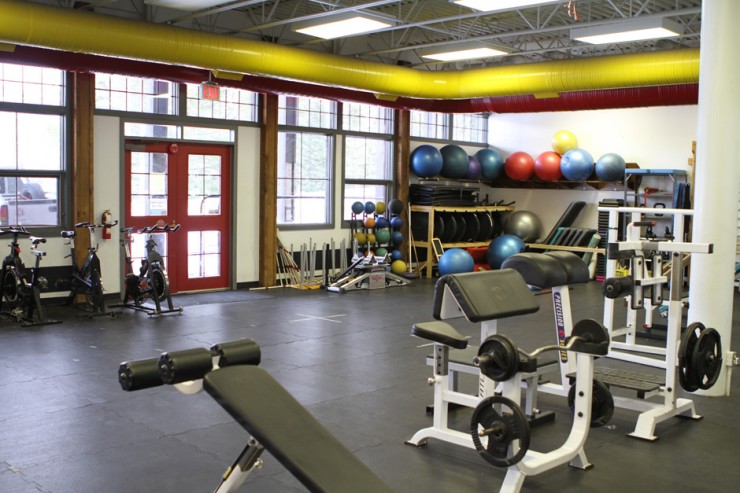
Andrew Johnson can do three sets of five dips with 110lbs hanging from his waist. Wendy Wagner can do three sets of five pull-ups with 40lbs hanging from her waist. Kris Freeman can hoist 220 pounds into the air by a doublepole pulley so fast and hard the whole machine trembles. Wadsworth’s stomach is a grotesque xylophone of muscle. There is no messing around in the weight room.
While many programs in the US treat general strength as a side addition to training, for us it is an integral part of the plan, of getting fast enough to win medals. We did two main blocks of max strength training where in we did five exercises three times each using weight so heavy it could only be lifted around five times per set. We focused on weighted pull-ups and dips, a double-pole simulation devised by Trond, and leg press – all using huge weight. In addition to this we did an extensive routine of core strength – mostly tossing heavy balls around using all the muscles of the stomach, hips and back. We also did some rollerboard with the board canted as steeply as possible, so steep it was frightening trying to mount the tipsy little seat. This routine we did three times a week. The weight session was always proceeded by a run of half an hour to an hour and once a week by the routine of spenst. Simple.
That is one day.
* * *
There’s more. Here are links to the rest of the series, along with excerpts from each installment.
Part two: Summer training: “I’m not giving you enough secrets. I have so far given you all of our secrets. ‘Our goals are shared and so is our success.’ That is team cohesion policy number 6. We dream together, work together and succeed together. There is a photo of Kris Freeman held aloft on the shoulders of his teammates after his fourth place at worlds. This is metaphorical. What is harder to show is that his teammates are also standing on his shoulders. Even harder yet to show: he is standing on the shoulders of all the coaches and people who have helped him in the past, of the athletes who have come before him, a whole network of support…and harder yet to show, that this country’s ski community as a whole is standing on his shoulders as well, his and Carl’s and the rest of the national team’s shoulders – waiting for that glimmer, waiting for the next Koch. Expecting something like trickle down economics. These skiers have the potential, via their international success, to pull American skiing up by the bootstraps. But they can’t succeed alone. We can’t do it alone.”
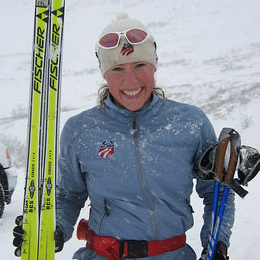
Part three: European campaign: “We actually have several potential medallists. We have Kikkan Randall, who has unfortunately suffered illness after illness early in the season, but who is an incredible talent and a potential medallist at U-23’s. We have Kristina Trygstad-Saari, who was 6th at Junior Worlds the previous year, and a Continental Cup winner earlier this season. We have Leif Zimmerman, who is a rising talent. We have Torin Koos who is a definite contender in the sprint. We have Andrew Newell who has proven himself to be the fastest sprint prelim racer in the country this year. Andy had the second fastest sprint prelim time at Junior Worlds this season and finished 7th there behind two of his US teammates – including Leif. There are others who are fast, but not yet fast enough – for now I won’t list them. They are skiers who will rise with time and training. I believe in them, and we have patience for them. This is a strong team. Chris Grover, Development Coach, has just come in from Junior Worlds and is in charge of the team.”

Part four: Final chapter, for this year: “The race [at Holmenkollen] is on. Kris is skiing in the top ten. Andrew and Carl are skiing in the top 30, Lars Flora and Dave Chamberlain, who both paid their own way here are in the 40’s. Dave dies first. His skis iced badly and he couldn’t fight it off. He came by me looking like a drowned rat. Andrew starts to die next, he falls down the results sheet with every km, but keeps fighting hard. Lars stays steady. Kris is still around the top 10 to 15. Carl starts to fade. Then Kris starts to fade. Things are going downhill, and then it starts to snow hard. The race blows up. This is ski racing. …
“I think this team is the New Koch just as Mathias [Fredriksson] is the next Gunde – or at least inasmuch as anyone can be. There will never be another Koch or another Gunde, but this team will be the next big thing.
“I’ll tell you now so you are not too surprised, at times we are going to fail and flail in route. We’re going to screw up and we’re going to piss people off and it won’t always be graceful, but we will attack this project with vigor, patience, and persistence. And squeezing it for one second at a time, we will succeed.”
Gavin Kentch
Gavin Kentch wrote for FasterSkier from 2016–2022. He has a cat named Marit.



